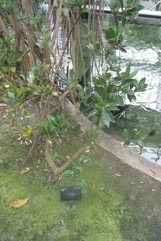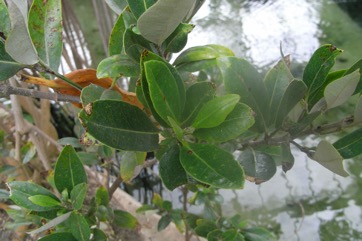White mangrove, Grey Mangrove

A tropical plant. It grows in the tropics but also extends into cooler regions. They are most commonly on the seaward edge of the mangroves. It grows in muddy soil with a pH of 6.5-8. It cannot tolerate shade. It can grow in salty soils. It can grow in arid places. It suits hardiness zones 10-12.
Also known as:
Afiafy, Artama, Baru, Dwarf mangrove, Gurm, Hafiafy, Hai lan, Honkofotsy, Manawa, Manyarr, Mchu, Mirirrwiny, Mosotro, Mtu, Ngurngulu, Smooth-barked Grey mangrove, Thinbir, Witseebasboom
Synonyms
- Avicennia alba Wight
- Sceura marina Forskal
Edible Portion
- Fruit, Seeds
Where does White mangrove grow?
Found in: Africa, America, Andamans & Nicobar, Arabia, Asia, Australia, Bahrain, Bangladesh, China, Comoros, East Africa, East Timor, Egypt, India, Indochina, Indonesia, Iran, Japan, Kenya, Madagascar, Maldives, Mozambique, Myanmar, New Caledonia, New Zealand, North Africa, Oman, Pacific, Pakistan, Papua New Guinea, PNG, Philippines, Qatar, Saudi Arabia, SE Asia, Singapore, Solomon Islands, South Africa, Southern Africa, Sri Lanka, Sudan, Taiwan, Tanzania, Thailand, Timor-Leste, United Arab Emirates, UAE, Vietnam, Yemen
Notes: There are about 6-8 Avicennia species. They are tropical. It was in the Avicenniaceae and Verbenaceae families.
Growing White mangrove, Grey Mangrove
Cultivation: Plants are often self sown. Seedlings can be transplanted.
Edible Uses: The fruit are eaten after roasting. They are extensively soaked and then cooked. CAUTION: The bitter juice is used to produced abortions in India.
Production: Trees in Australia flower from October to January and fruit January to February.
Nutrition Info
per 100g edible portion| Edible Part | Energy (kcal) | Protein (g) | Iron (mg) | Vitamin A (ug) | Vitamin c (mg) | Zinc (mg) | % Water |
|---|---|---|---|---|---|---|---|
| Fruit | - | - | - | - | - | - |
White mangrove, Grey Mangrove Photos


References
Ambasta S.P. (Ed.), 2000, The Useful Plants of India. CSIR India. p 63
Bindon, P., 1996, Useful Bush Plants. Western Australian Museum. p 47
Boomsma, C.D., 1972, Native Tree of South Australia. Woods & Forests Department South Australia, Bulletin No.19. p 53
Brock, J., 1993, Native Plants of Northern Australia, Reed. p 93
Cancilla, D., 2018, Ethnobotanical and Ethnozoological Values Desktop Assessment - Eliwana Project. p 37
Cherikoff V. & Isaacs, J., The Bush Food Handbook. How to gather, grow, process and cook Australian Wild Foods. Ti Tree Press, Australia p 198
Clarke, P. A., 2013, The Aboriginal Ethnobotany of the Adelaide Region, South Australia. Transactions of the Royal Society of South Australia. (2013), 137(1): 97-126
Cooper, W. and Cooper, W., 2004, Fruits of the Australian Tropical Rainforest. Nokomis Editions, Victoria, Australia. p 86
Cronin, L., 1989, The Concise Australian Flora. Reed. p 148
Cundall, P., (ed.), 2004, Gardening Australia: flora: the gardener's bible. ABC Books. p 210
Dashorst, G.R.M., and Jessop, J.P., 1998, Plants of the Adelaide Plains & Hills. Botanic Gardens of Adelaide and State Herbarium. p 122
Denkschr. Kaiserl. Akad. Wiss. Wien, Math.-Naturwiss. Kl. 71:435. 1907
Dharani, N., 2002, Field Guide to common Trees & Shrubs of East Africa. Struik. p 299
Elliot, W.R., & Jones, D.L., 1982, Encyclopedia of Australian Plants suitable for cultivation. Vol 2. Lothian. p 264
Etherington, K., & Imwold, D., (Eds), 2001, Botanica's Trees & Shrubs. The illustrated A-Z of over 8500 trees and shrubs. Random House, Australia. p 109
Flora of Pakistan.
Floyd, A.G., 1977, Ecology of the Tidal Forests in the Kikori-Romilly Sound Area Gulf of Papua. Ecology Report No 4 Division of Botany, Lae, Papua New Guinea. p 26
French, B.R., 1986, Food Plants of Papua New Guinea, Asia Pacific Science Foundation p 314
French, B.R., 2010, Food Plants of Solomon Islands. A Compendium. Food Plants International Inc. p 299
Frodin, D.G. & Leach, G.L., 1982, Mangroves of the Port Moresby Region. Biology Department Occasional Paper No 3 Revised edition. Papua New Guinea, p 18 (Avicennia eucalyptifolia - part)
Havel, J.J., 1975, Forest Botany, Volume 3 Part 2 Botanical taxonomy. Papua New Guinea Department of Forests, p 283
Hiddins, L., 1999, Explore Wild Australia with the Bush Tucker Man. Penguin Books/ABC Books. p 144
Holliday, I., 1989, A Field Guide to Australian Trees. Hamlyn. p 68
http://iscmumbai.maharashtra.gov.in/floristic%20survey.html
Hu, Shiu-ying, 2005, Food Plants of China. The Chinese University Press. p 642
Isaacs, J., 1987, Bush Food, Aboriginal Food and Herbal Medicine. Weldons. p 129
Kenneally, K.E., Edinger, D. C., and Willing T., 1996, Broome and Beyond, Plants and People of the Dampier Peninsula, Kimberley, Western Australia. Department of Conservation and Land Management. p 70
Lands, M., 1987, Mayi: Some Bush fruits of Dampierland. Magabala Books, Broome West Australia. p 24
Lazarides, M. & Hince, B., 1993, Handbook of Economic Plants of Australia, CSIRO. p 30
Levitt, D., 1981, Plants and people. Aboriginal uses of plants on Groote Eylandt, Australian Institute of Aboriginal Studies, Canberra. p 84
Lovelock, C., & Clarke, S., 1999, Field Guide to the Mangroves of Queensland. Australian Institute of Marine Science. p 50
Low, T., 1991, Wild Food Plants of Australia. Australian Nature FieldGuide, Angus & Robertson. p 45
Low, T., 1992, Bush Tucker. Australia’s Wild Food Harvest. Angus & Robertson. p 83
Paczkowska, G. & Chapman, A.R., 2000, The Western Australian Flora. A Descriptive Catalogue. Western Australian Herbarium. p 180
Palgrave, K.C., 1996, Trees of Southern Africa. Struik Publishers. p 816
Percival, M & Womersley, J.S., 1975, Floristics and ecology of the mangrove Vegetation of Papua New Guinea. Botany Bulletin No 8 Division of Botany, Lae, Papua New Guinea. p 40
Phillips, D.C., 1988, Wild Flowers of Bahrain. A Field Guide to Herbs, Shrubs, and Trees. Privately published. p 29
Price, S.H. & J.L., Wild Food, Medicine and useful plants of the Wet tropics. Kwik Kopy, Cairns. p 6
Roy, S. D., et al, 2009, Mangroves of Andaman and Nicobar Islands. ICAR p 11
Royal Botanic Gardens, Kew (1999). Survey of Economic Plants for Arid and Semi-Arid Lands (SEPASAL) database. Published on the Internet; http://www.rbgkew.org.uk/ceb/sepasal/internet [Accessed 4th April 2011]
Ruiters-Welcome, A. K., 2019, Food plants of southern Africa. Ph.D. thesis. Univ. of Johannesburg p 5
Scarth-Johnson, V., 2000, National Treasures. Flowering Plants of Cooktown and Northern Australia. Vera Scarth-Johnson Gallery Association. Cooktown, Australia. p 20
Schatz, G.E., 2001, Generic Tree Flora of Madagascar. Royal Botanical Gardens, Kew and Missouri Botanical Garden. p 37
Selvam, V., 2007, Trees and shrubs of the Maldives. RAP Publication No. 2007/180
Smith, M & Kalotas, A. C., 1985, Bardi Plants: An Annotated List of Plants and Their Use by the Bardi Aborigines of Dampierland, in North-western Australia. Rec. West Aust. Mus. 1985, 12(3): 317-359
Smith, N and Wightman, G.M., 1990, Ethnobotanical Notes from Belyuen Northern Territory Australia. Northern Territory Botanical Bulletin No 10. Parks and Wildlife Commission of the Northern Territory. p 5, 6.
Smith, N. M., 1991, Ethnobotanical Field Notes from the Northern Territory, Australia, J. Adelaide Bot. Gard. 14(1): 1-65
Sujanapal, P., & Sankaran, K. V., 2016, Common Plants of Maldives. FAO & Kerala FRI, p 48
Tiwi Plants and Animals. 2001, Aboriginal flora and fauna knowledge from Bathurst and Melville Islands, northern Australia. Northern Territory Botanical Bulletin; No. 24 p 26
van Wyk, B, van Wyk, P, and van Wyk B., 2000, Photographic guide to Trees of Southern Africa. Briza. p 57
Vigilante, T., et al, 2013, Island country: Aboriginal connections, values and knowledge of the Western Kimberley islands in the context of an island biological survey. Records of the Western Australian Museum Supplement 81: 145-182
Wheeler, J.R.(ed.), 1992, Flora of the Kimberley Region. CALM, Western Australian Herbarium, p 800
World Checklist of Useful Plant Species 2020. Royal Botanic Gardens, Kew
Young, J., (Ed.), 2001, Botanica's Pocket Trees and Shrubs. Random House. p 119